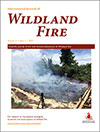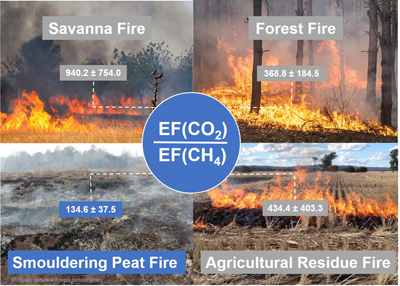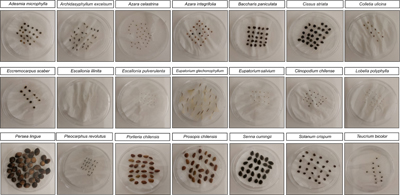International Journal of Wildland Fire
Volume 31
Number 11 2022
This study estimates the smoke emissions from Portuguese extreme wildfires events using a bottom-up approach with high spatial and temporal resolution. Fire data were used, such as ignition location and time, propagation, burned area, and fuel load and emission factors according to forest species.
Smoke cover over valleys may reduce wildfire severity by affecting weather. We quantified the effect of smoke cover on fire severity for 106 fires in the Klamath Mountains, USA. Smoke reduced fire severity at low elevations as expected, yet side slopes just above smoke plumes experienced more severe fire effects.
Systematic comparisons and statistical analysis of emission factor (EF) data from the literature show that the EF ratio of CO2 to CH4 presents the best gas signature for early detection of smouldering peat fire from flaming fires and the burning of various wildfire fuels in the field.
We investigated wildfire incidence in western Greenland since 1995 and found at least 21 fire events from remote sensing analysis and national news reports. Fire has been a relatively common occurrence for at least the past 12–15 years, during a period of observed regional warming and reduced precipitation.
We used the unsupervised machine learning clustering algorithm HDBSCAN to identify high-density human- and lightning-caused wildland fire ignition clusters in British Columbia, Canada. Generally, human-ignition clusters occurred close to population centres and roads, while large lightning-ignition clusters seemed related to ecozones. Significant differences in fuel types were associated with both.
Autumn precipitation and Santa Ana winds are opposing determinants of fire outcomes in California’s South Coast region. Most of the area burned in autumn through early winter during 1948–2018 occurred from fires started before the onset of precipitation, defined as the first autumn event with 8.5 mm or greater precipitation.
A framework is proposed for generating the fastest yet safest fireline path. Fireline construction is modelled considering a fire’s propagation on a dynamic network that represents a heterogeneous landscape. The optimal fireline path algorithm can be used to inform decisions for more effective and efficient fire suppression strategies.
We provide evidence of the negative impact of wildfires on the seeds of most of the woody species of the Chilean matorral, the only Mediterranean flora that has not been shaped by a natural wildfires regime. Our results emphasise the necessity of germplasm banks for post-fire restoration planning in this ecoregion.
 , S. Sorte, A. Monteiro, C. Gama, J. Reis, I. Menezes, T. Osswald
, S. Sorte, A. Monteiro, C. Gama, J. Reis, I. Menezes, T. Osswald  , C. Borrego, M. Almeida, L. M. Ribeiro, D. X. Viegas and A. I. Miranda
, C. Borrego, M. Almeida, L. M. Ribeiro, D. X. Viegas and A. I. Miranda






